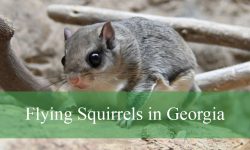Squirrels are among the most familiar and energetic animals found throughout Michigan’s diverse natural environments. From bustling city parks to remote northern forests, squirrels can be seen darting through trees, gathering food, or scurrying across forest floors. Their presence is an essential part of the state’s ecosystem, contributing to seed dispersal and forest regeneration.
This guide explores 9 Types of Squirrels in Michigan, including tree squirrels, ground squirrels, chipmunks, and flying squirrels. Each species displays unique characteristics, behaviors, and habitat preferences. While some thrive in suburban environments, others are found only in secluded woodland areas or grasslands.
Learning more about the Types of Squirrels in Michigan can make outdoor adventures more engaging and informative. With the help of detailed descriptions and identification tips, it becomes easier to spot these fascinating animals and understand their role in Michigan’s natural landscapes.
Different Types of Squirrels in Michigan
Eastern Fox Squirrel (Sciurus niger)
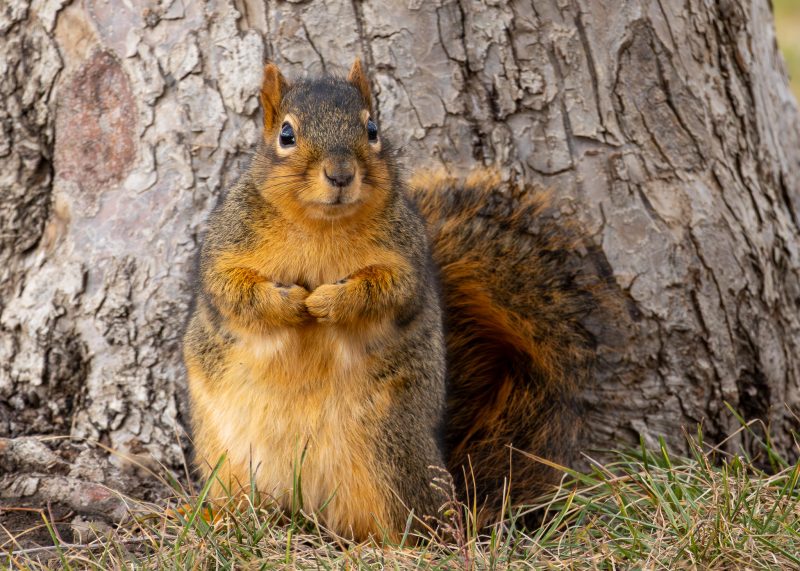
The Eastern Fox Squirrel is the largest species of tree squirrel in Michigan, easily recognized by its robust size and distinctive coloration. It usually sports a reddish-brown or orange-tinged coat with a bushy tail that adds to its visual bulk. Some individuals may appear grayer or more yellowish depending on their specific region. Adults can grow up to 27 inches in length including the tail, and they weigh about 1.5 to 2 pounds. Their strong limbs and sharp claws make them adept climbers, although they are often seen foraging on the ground.
These squirrels are commonly found throughout the southern Lower Peninsula of Michigan, where they prefer open woodlands, edge habitats, and even urban parks. Unlike some of their more forest-dependent relatives, Eastern Fox Squirrels are highly adaptable to human presence and often nest in large deciduous trees in residential neighborhoods. They build leafy nests, known as dreys, or use tree cavities when available, especially during colder months.
Eastern Fox Squirrels are primarily active during the day and spend much of their time foraging for food such as acorns, walnuts, seeds, fruits, and even bird eggs. In autumn, they exhibit caching behavior, burying food to retrieve later during the winter. Their role in seed dispersal helps maintain the health of forest ecosystems. Despite being the largest, they are generally solitary and territorial but may share feeding grounds when resources are plentiful.
Eastern Gray Squirrel (Sciurus carolinensis)
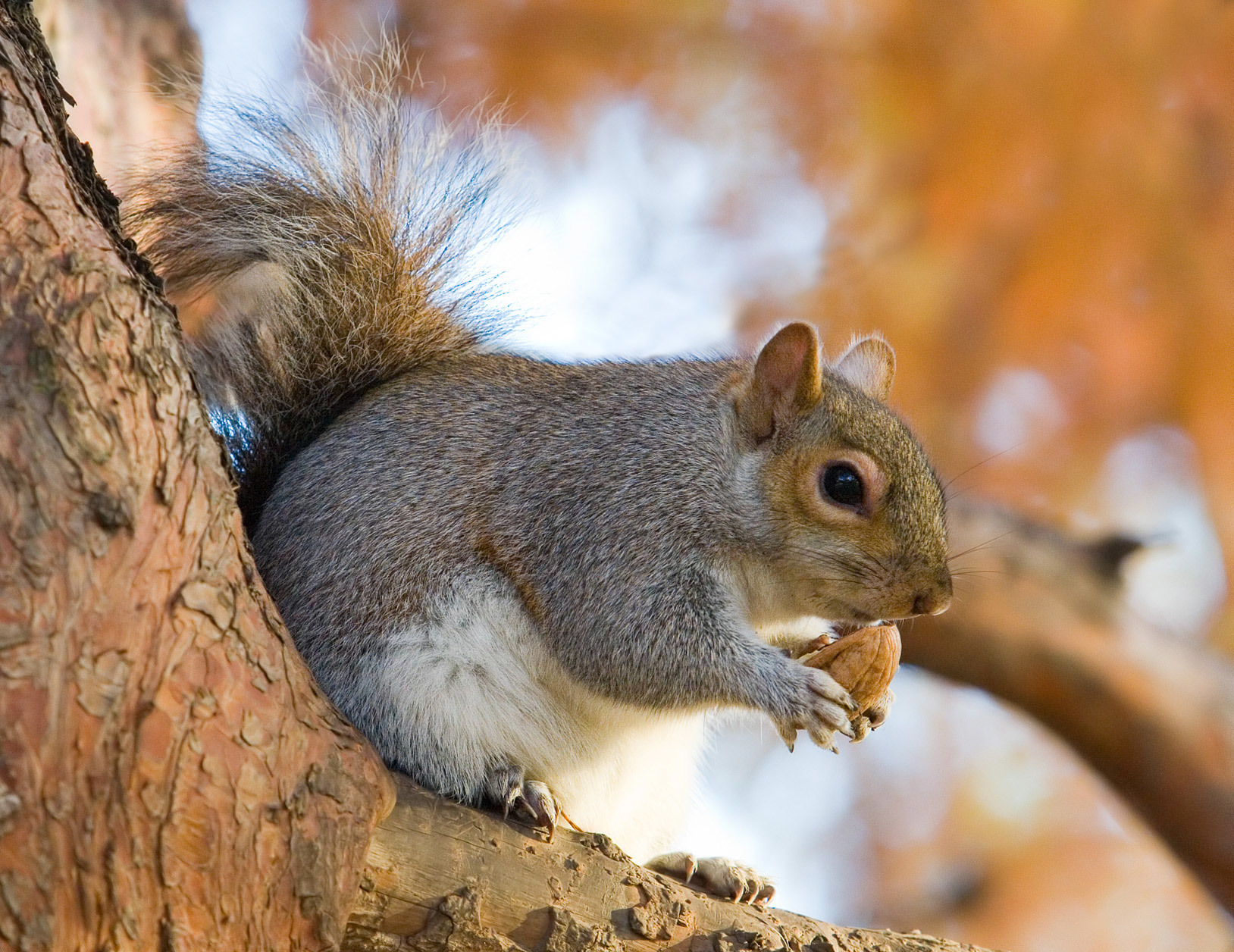
The Eastern Gray Squirrel is one of the most widespread and familiar squirrels in Michigan. Its coat is typically gray with a white underbelly, though black morphs—especially common in Michigan—are often mistaken for a separate species. Adult Eastern Gray Squirrels can grow up to 20 inches in length and are slightly smaller and slimmer than Fox Squirrels. Their large eyes, fluffy tail, and agile movement make them excellent climbers and leapers among the treetops.
These squirrels thrive across both urban and rural areas throughout Michigan, including cities, college campuses, parks, and hardwood forests. They are highly adaptable and tend to coexist easily with humans, often raiding bird feeders and scavenging from garbage when food is scarce. In natural settings, they prefer forests with mature trees that provide ample nesting opportunities and food resources.
Eastern Gray Squirrels are diurnal and most active during the early morning and late afternoon. They have a varied diet consisting of nuts, seeds, fungi, and fruits, but are also known to gnaw on bark and even bones to obtain minerals. Like other squirrels, they practice food caching in fall. Interestingly, their memory is impressive when it comes to retrieving hidden food. They communicate using a mix of vocalizations and tail movements, especially when threatened or defending territory.
American Red Squirrel (Tamiasciurus hudsonicus)

The American Red Squirrel is much smaller than both the Gray and Fox Squirrels, with a compact body, reddish fur, and a white or pale underbelly. Adults usually measure around 12 inches in length, including the tail, and weigh between 5 to 9 ounces. Their bold personality often belies their small size—they are known for being vocal, feisty, and fiercely territorial, especially during the breeding season or near their food caches.
In Michigan, American Red Squirrels are primarily found in coniferous forests, particularly in the northern Lower Peninsula and throughout the Upper Peninsula. However, they can also adapt to mixed woodlands where pine, spruce, or fir trees are dominant. These squirrels are arboreal and construct globular nests high in trees, although they also use tree cavities when available. They are less common in suburban areas compared to Gray and Fox Squirrels.
Red Squirrels feed extensively on conifer seeds and are particularly fond of pine cones, which they strip and hoard in large middens at the base of trees. Their diet also includes fungi, berries, and occasionally bird eggs or insects. Unlike other squirrels that bury individual nuts, red squirrels store food in concentrated areas. This species is active year-round, and their chattering calls and tail flicks are familiar sounds in northern forests, especially when warning intruders or predators.
Northern Flying Squirrel (Glaucomys sabrinus)
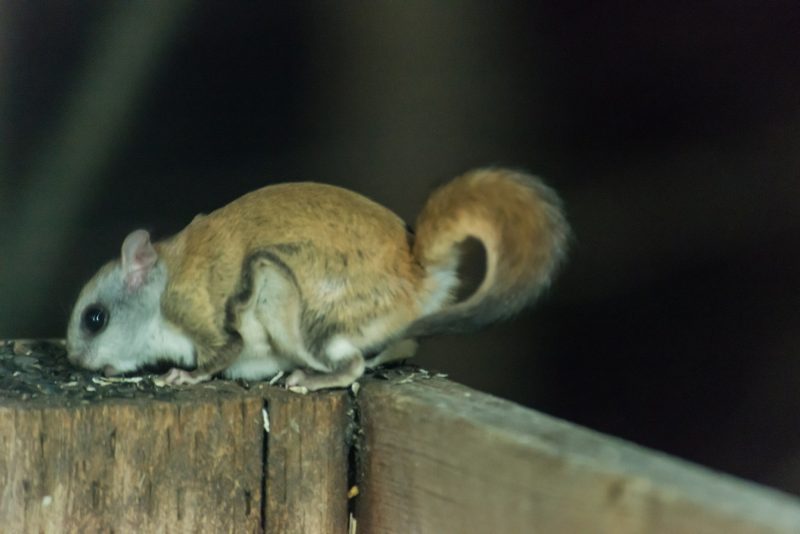
The Northern Flying Squirrel is a nocturnal and rarely seen resident of Michigan’s northern forests. Unlike true flight, these squirrels glide gracefully between trees using a flap of skin called the patagium, which stretches from their wrists to their ankles. They have soft, grayish-brown fur, a flat tail, and large, dark eyes adapted for excellent night vision. Adults typically measure about 10 to 12 inches long and weigh only 3 to 5 ounces.
This species primarily inhabits mature coniferous and mixed forests in the northern Lower Peninsula and throughout the Upper Peninsula of Michigan. They prefer old-growth stands with plenty of tree cavities, snags, and dense canopies that facilitate gliding. They are extremely elusive and are rarely seen during daylight hours, which makes studying their population trends a challenge. Nesting occurs in tree holes or abandoned woodpecker nests, often lined with moss and lichen.
Northern Flying Squirrels feed on a variety of foods, including nuts, seeds, fruits, lichens, fungi, and insects. They are especially important for their role in dispersing fungal spores—particularly mycorrhizal fungi, which are essential to forest health. Despite being quiet and secretive, they are social animals and may nest communally in colder months for warmth. Their presence in an area is often only detected through specialized nighttime surveys or the discovery of gliding tracks in snow.
Southern Flying Squirrel (Glaucomys volans)
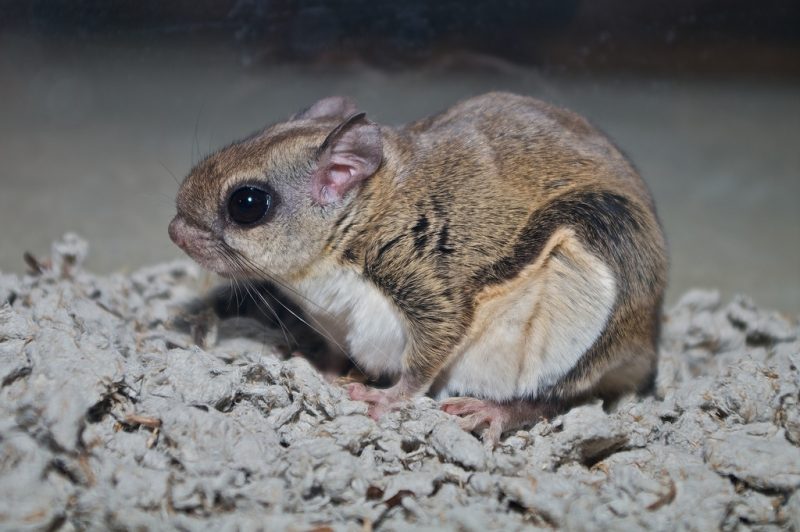
The Southern Flying Squirrel is a small, nocturnal glider that resembles its northern cousin but is slightly smaller in size and more common in southern Michigan. With soft, grayish-brown fur, a white underbelly, and large dark eyes, this species is perfectly adapted to life in the treetops. Like the Northern Flying Squirrel, it uses a skin membrane called the patagium to glide silently between trees, allowing it to travel long distances in search of food or mates.
In Michigan, Southern Flying Squirrels are found mostly in the southern Lower Peninsula, where they favor deciduous forests rich in hardwoods like oak, hickory, and beech. These environments offer ample food resources and natural cavities for nesting. They are seldom seen due to their strictly nocturnal habits, but their presence may be detected by finding their nests in tree hollows or by using trail cameras and night surveys.
Their diet is diverse and includes nuts, seeds, berries, fungi, and insects. They are particularly fond of acorns and may cache food for winter use. Although they are quiet by nature, Southern Flying Squirrels communicate using high-pitched vocalizations and scents. During colder months, they often huddle together in shared nests to stay warm. Their role in seed dispersal and forest ecology makes them important despite their secretive nature.
Eastern Chipmunk (Tamias striatus)

The Eastern Chipmunk is a small, diurnal ground squirrel easily recognized by its reddish-brown fur and five dark stripes running down its back. It has prominent cheek pouches used for carrying food and is often seen darting along forest floors or scurrying up logs and rocks. Adult chipmunks grow to about 8 to 10 inches long, including their tail, and weigh between 2.5 to 5 ounces.
These chipmunks are widespread throughout both peninsulas of Michigan and are common in woodlands, parks, gardens, and suburban yards. They dig extensive burrow systems with multiple entrances, storage chambers, and sleeping areas. Active during the day, they spend their time foraging and collecting food such as nuts, seeds, fruits, insects, and even small amphibians.
Eastern Chipmunks are solitary creatures and fiercely defend their territories, especially around burrow entrances. They vocalize with high-pitched chips and trills when alarmed or communicating. In the fall, they prepare for winter by gathering and storing food underground. Unlike some squirrels, they don’t hibernate continuously but enter periods of torpor, waking occasionally to eat from their caches. Their charming behavior and visibility make them a familiar presence in Michigan’s natural and urban landscapes.
Least Chipmunk (Tamias minimus)
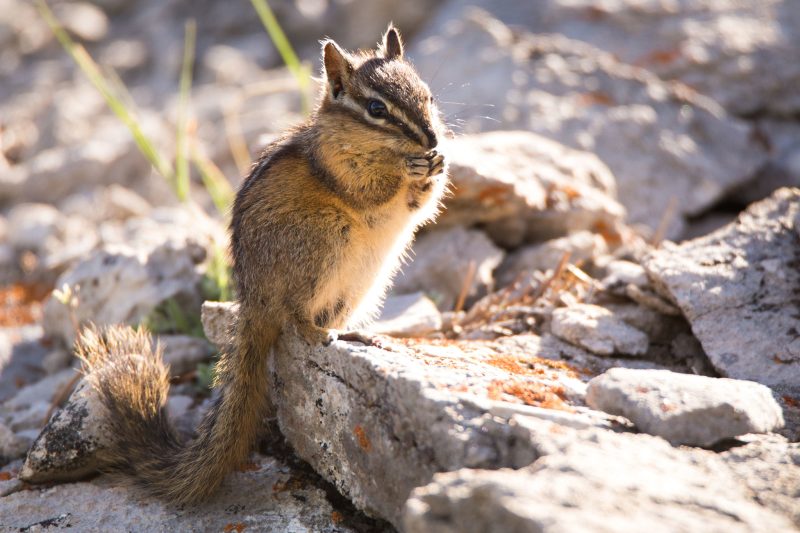
The Least Chipmunk is the smallest of Michigan’s chipmunks, measuring only 7 to 8 inches in total length, including a slender tail. It has a more delicate build compared to the Eastern Chipmunk, with lighter fur and five narrow, dark stripes on its back and face. Despite its small size, it is a highly active and agile creature, often seen scurrying among rocks and brush.
This species is found primarily in the Upper Peninsula and prefers open coniferous forests, shrublands, and rocky areas. It is less common than its eastern counterpart and tends to inhabit more remote, undisturbed environments. Like other chipmunks, it creates underground burrows but may also shelter in hollow logs or under brush piles. It is diurnal and spends much of the day foraging.
The Least Chipmunk has a varied diet that includes seeds, berries, insects, and fungi. It stores food in cheek pouches to carry back to its burrow for later use. During the winter, it enters a state of torpor but periodically wakes to feed. This species is known for its quick movements and alert nature, making it difficult to spot in the wild. Its presence is more likely to be noticed in quiet northern habitats where it remains an elusive but important member of the forest ecosystem.
Thirteen-lined Ground Squirrel (Ictidomys tridecemlineatus)
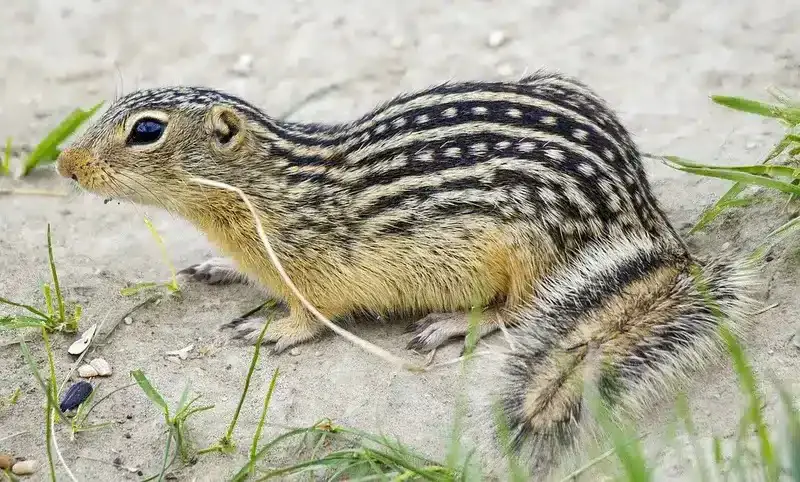
The Thirteen-lined Ground Squirrel is easily identified by the thirteen alternating light and dark stripes running lengthwise down its back and sides. This small, slender ground squirrel grows to about 9 to 12 inches in length and has a short tail. It is a ground-dwelling species that rarely climbs and is most active on sunny days during the warmer months.
In Michigan, this species is more prevalent in the southern parts of the Lower Peninsula, where it inhabits open grasslands, prairies, mowed lawns, and roadsides. It prefers dry, well-drained soils for digging its burrow systems, which can extend several feet underground. These squirrels are solitary and highly territorial, with individual burrows used for nesting, food storage, and hibernation.
Thirteen-lined Ground Squirrels feed on seeds, grains, insects, and occasionally small vertebrates. They are especially known for their appetite for grasshoppers and beetles, making them helpful in controlling pest populations. This species hibernates during winter, entering a deep sleep that lasts from late fall until early spring. Their alert stance—often seen standing upright to scan for predators—makes them a familiar sight in open landscapes during the summer months.
Woodchuck or Groundhog (Marmota monax)
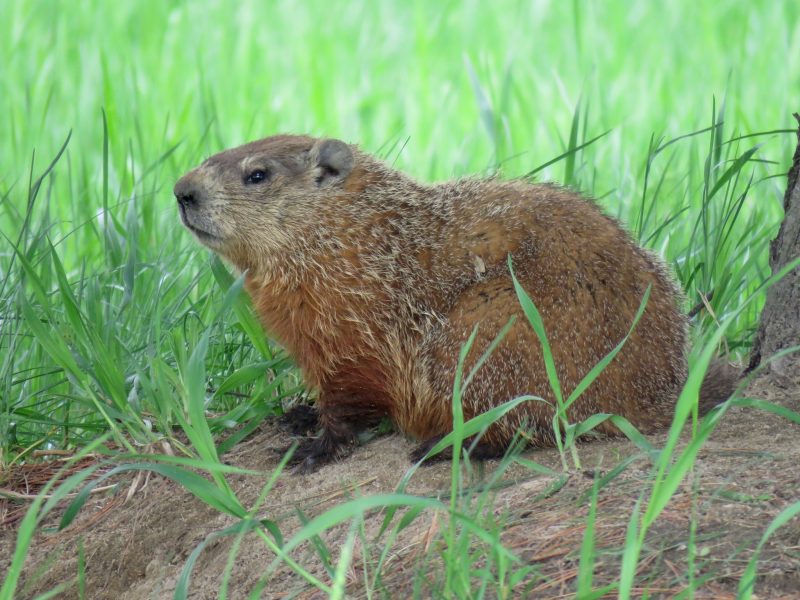
The Woodchuck, also known as the Groundhog, is the largest member of the squirrel family found in Michigan. Adults can weigh between 5 to 14 pounds and grow up to 25 inches in length. They have coarse brown fur, short legs, and strong claws adapted for digging. Their stocky build and waddling gait make them easy to distinguish from other local rodents.
Woodchucks are common throughout both the Lower and Upper Peninsulas of Michigan and are frequently found in open fields, pastures, meadows, and along the edges of woodlands. They are excellent diggers and construct extensive burrow systems with multiple entrances, which serve as shelter, nesting areas, and protection from predators. These burrows can be found near rock piles, fence lines, or even under decks and sheds in suburban areas.
Primarily herbivorous, Woodchucks feed on a wide variety of vegetation, including grasses, clover, dandelions, and crops such as corn and soybeans. They are solitary animals and are most active during the early morning and late afternoon. In preparation for winter, they accumulate fat reserves and hibernate from late fall until early spring. Woodchucks are perhaps best known for their association with Groundhog Day, a folklore tradition that adds a whimsical touch to their otherwise secretive lifestyle.


